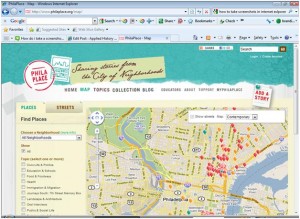My fabulous public history project focused on the website, philaplace.org. The site is called “PhilaPlace: Sharing Stories from the City of Neighborhoods.” This project shows two maps: An image of historic Philadelphia, and underlying that one is a modern Google map. The project allows you to explore historic locations with photographs, stories, and place markers. A very nice interactive portion of this website is that it lets users contribute their own stories to the website. It also has a blog, and a collections tab that opens up over 1,000 photos.
This project was created by the Historical Society of Pennsylvania to feature Philadelphia neighborhoods, and allow people to contribute in order to connect “places through space and time.” They created the website for people to understand and interact with the history of Philadelphia, as well as document the changes that have occurred in the cityscape.
The project’s intended audience seems to be primarily the residents of the featured neighborhoods of Philadelphia. There seems to be room for improvement in this area to include travelers or potential travelers. A tourist could use the website, but by incorporating a couple of walking tours in certain areas or using location based apps the experience would be improved.
The learning objective of this website is much like our textbook, Everyday America; to read the cultural landscapes of Philadelphia and acknowledge the many experiences that have occurred in one place, even one building. One of the other objectives of this project is for the visitors to realize how each neighborhood, no matter how different they are, have played integral roles in the shaping of the city and the region.
This project is replicable, but I think an organization with enough resources would have to undertake it. One of the project pages mentions that several organizations partnered together and had at least two large grants. With technology becoming cheaper as they roll out new interfaces, cost might not be much of a deterrent for long because the cost is becoming more affordable. At the moment it is a great template for other projects. As for the PhilaPlace project as it exists now on the web, it can easily grow and have more content added to it.
Participation in the project by the public was an integral part to the project. It remains a part of the project still by allowing visitors to write their own stories down about places. Visitor comments are marked with a green thumbtack on the map, and comments from the Historical Society and other partners are also clearly marked. This is a very convenient part of the site because you can easily see who is interacting with it, and who is not. It seems as if not enough people have discovered it to share their memories about the places, or they are targeting the wrong age group.
I think this is a great project to bring to Boise, and with a couple of tweaks, it could become really prominent with social media and other avenues. By using social media, I think it would help encourage more engagement by the public. That seems to be one of the downsides of the PhilaPlace; not very many people outside of the historical society and their partners have shared stories. Perhaps a more vigorous media campaign would help that. If a similar project was undertaken in Boise, I think the addition of audio would be great. With audio, the group in charge of operating the site could gather anecdotal oral histories and upload them to the site too. I think this kind of project could become a nice balance of an educational and fun web experience, with both what users want and what historians think they want.

This is really cool! I love the idea of using interactive media to link places and spaces through time. Targeting just people in Philadelphia makes sense, and I’m sure it kind of fosters a sense community for those who use it. Being that it’s such a historic city, I imagine there are a lot of things that would open it up for tourists. This is a totally different kind of project than the one I looked at (digitized primary sources), but is similar in that it makes history more tangable by putting the user in the drivers seat. I wonder how long and how much money it took to get PhilaPlace up and running?